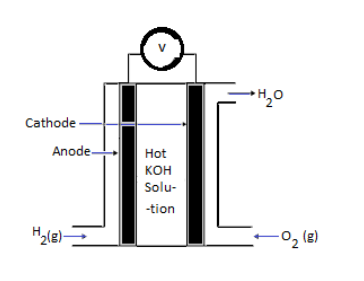
Draw a neat labelled diagram of
Answer
467.4k+ views
Hint:A fuel cell is an electrochemical cell that converts the chemical energy into electrical energy. Hydrogen is used as a fuel and oxygen is used as an oxidizing agent which converts electrochemical energy into electricity through a pair of redox reactions. Fuel cells can produce electricity continuously as long as fuel and oxygen are supplied to it.
Complete answer:
In
At the anode, the catalyst breaks the hydrogen molecules into electrons and protons.
At cathode, the following reaction takes place:
Labelled diagram of fuel cell:

Additional information:
Some advantages of hydrogen fuel cells are: Hydrogen fuel cells are cleaner and more efficient than traditional combustion-based engines and power plants. Hydrogen and fuel cells can also be used in mobile applications to power vehicles and mobile power packs. The benefits of fuel cells are: Reduced greenhouse gas emissions.
Note:
There are some disadvantages of hydrogen fuel cells too. As hydrogen gas is expensive and it is very difficult to store the gas. It is also not easy to replace the existing infrastructure. Though it is a powerful source of fuel so hydrogen can be very flammable. As hydrogen energy is renewable and has a minimal environmental impact, other non-renewable sources such as coal, oil and natural gas are often used to separate it from oxygen. But the point of switching to hydrogen is to get rid of using fossil fuels, fossil fuels are still used to produce hydrogen fuel. Renewable energy like solar and wind can be used to generate hydrogen energy.
Complete answer:
In
At the anode, the catalyst breaks the hydrogen molecules into electrons and protons.
At cathode, the following reaction takes place:
Labelled diagram of fuel cell:

Additional information:
Some advantages of hydrogen fuel cells are: Hydrogen fuel cells are cleaner and more efficient than traditional combustion-based engines and power plants. Hydrogen and fuel cells can also be used in mobile applications to power vehicles and mobile power packs. The benefits of fuel cells are: Reduced greenhouse gas emissions.
Note:
There are some disadvantages of hydrogen fuel cells too. As hydrogen gas is expensive and it is very difficult to store the gas. It is also not easy to replace the existing infrastructure. Though it is a powerful source of fuel so hydrogen can be very flammable. As hydrogen energy is renewable and has a minimal environmental impact, other non-renewable sources such as coal, oil and natural gas are often used to separate it from oxygen. But the point of switching to hydrogen is to get rid of using fossil fuels, fossil fuels are still used to produce hydrogen fuel. Renewable energy like solar and wind can be used to generate hydrogen energy.
Latest Vedantu courses for you
Grade 10 | MAHARASHTRABOARD | SCHOOL | English
Vedantu 10 Maharashtra Pro Lite (2025-26)
School Full course for MAHARASHTRABOARD students
₹33,300 per year
Recently Updated Pages
Master Class 9 General Knowledge: Engaging Questions & Answers for Success

Master Class 9 English: Engaging Questions & Answers for Success

Master Class 9 Science: Engaging Questions & Answers for Success

Master Class 9 Social Science: Engaging Questions & Answers for Success

Master Class 9 Maths: Engaging Questions & Answers for Success

Class 9 Question and Answer - Your Ultimate Solutions Guide

Trending doubts
Give 10 examples of unisexual and bisexual flowers

Draw a labelled sketch of the human eye class 12 physics CBSE

Differentiate between homogeneous and heterogeneous class 12 chemistry CBSE

Differentiate between insitu conservation and exsitu class 12 biology CBSE

What are the major means of transport Explain each class 12 social science CBSE

What is the difference between resemblance and sem class 12 social science CBSE




